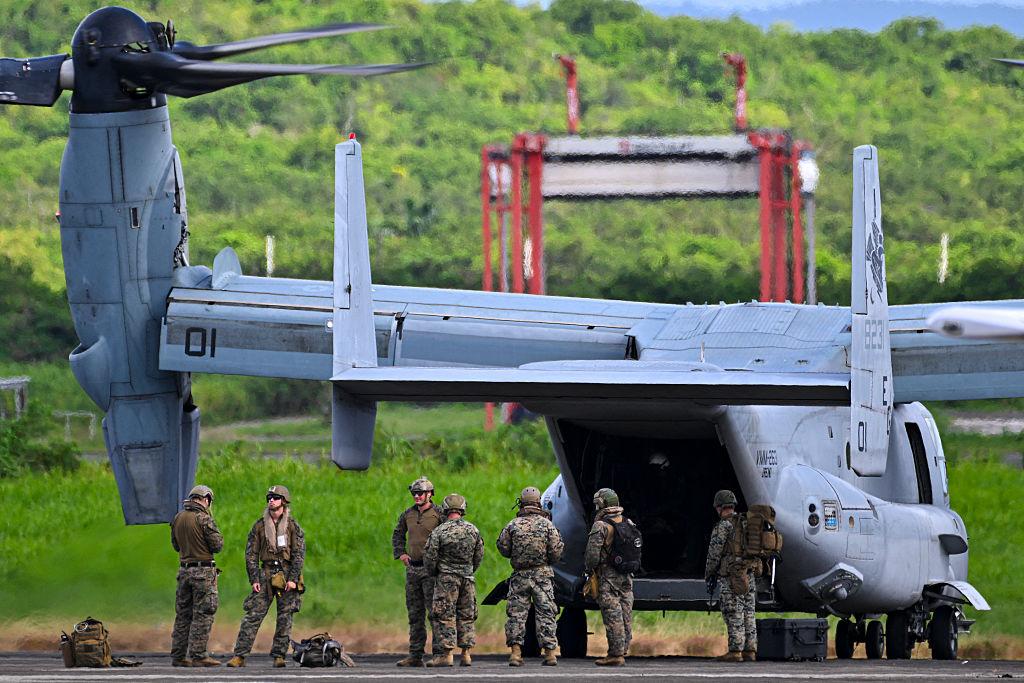The sight from Puerto Rico’s southern coast was surreal. Off the usually tranquil shores of Arroyo and Guayanilla, beachgoers watched in disbelief as helicopters whirred and the USS Iwo Jima, an amphibious assault ship, appeared from nowhere. Many scrolled through their phones for information, trying to make sense of what they were seeing.
The Marines began large-scale amphibious warfare maneuvers, disembarking hundreds of troops around August 31, 2025, as part of a U.S. military buildup amid rising tensions with Venezuela. Puerto Rico now hosts approximately 10,000 troops, including Marine Corps F-35 fighter jets, Air Force MQ-9 Reaper drones, a range of surveillance aircraft and support personnel. Officials in Washington have described the activity as “regional readiness,” while U.S. naval vessels move closer to Venezuelan waters under the campaign against so-called “terrorist drug cartels.” On October 31, the U.S. Federal Aviation Administration—under direction from the Department of Defense—established “Temporary Flight Restrictions for Special Security Reasons” off the southeast coast of Ceiba, in place through March 31, 2026. The move deepened local anxieties
By expanding these operations and reactivating former bases such as Roosevelt Roads Naval Base in Ceiba, the United States is reviving a chapter many Puerto Ricans believed had ended. Roosevelt Roads was closed in 2004, a year after the Navy abandoned its bombing range in Vieques following years of mass protests. At the time, Admiral Robert Natter, commander of the Atlantic Fleet, stated bluntly: “Without Vieques, there is no way I need the Navy facilities at Roosevelt Roads—none.” Two decades later, that logic has been reversed.
Read More: How Puerto Rico’s Colonial Status Deepens the Immigration Crisis
The remilitarization of Puerto Rico has sparked divided reactions. Some, including the governor, frame it as a symbol of U.S. partnership and security. But for others, the ongoing buildup—including renewed presence of heavy equipment and reports that President Trump authorized covert CIA operations against Venezuela—raises fears that Puerto Rico could once again become a live-fire zone.
These fears are not unfounded. The history of U.S. military bases in Puerto Rico is, at its core, a history of political interests rather than protection. Since the 1898 invasion, the island has functioned less as a shield than a springboard for U.S. power, pulling Puerto Rico into regional conflicts and peril, including during the 1962 Cuban Missile Crisis. Bases such as Roosevelt Roads, Ramey Air Force Base, Fort Buchanan, and Camp Santiago were built to advance American interests and confront perceived threats, from Nazi submarines in World War II to communist movements during the Cold War—and now, the 21st-century “war on cartels.”
For decades, the U.S. Navy used Puerto Rico’s offshore islands for live-fire training, displacing residents and destroying ecosystems. The justification was always the same: the Navy needed “realistic training sites.” Puerto Ricans, denied political representation, had no say in the matter. By the 1950s, Roosevelt Roads had become a linchpin of U.S. Southern Command operations, coordinating intelligence and logistics for interventions across Latin America. Military planners called Puerto Rico the “unsinkable aircraft carrier” of the Caribbean, a fixed platform for enforcing U.S. dominance in the region.
At the height of the Cold War, the U.S. military controlled roughly 13 percent of Puerto Rican land. Entire communities were uprooted in Ceiba, Vieques, and Culebra. Agriculture and fishing collapsed, and the promised economic benefits never arrived. Most jobs were temporary; profits went to U.S. contractors.
Environmental damage was extensive. Decades of bombing left Vieques littered with unexploded ordnance and contaminated with heavy metals. Cancer rates and respiratory illnesses soared. The death of civilian guard David Sanes Rodríguez in 1999 during a bombing exercise ignited a mass movement that ultimately forced the Navy’s withdrawal in 2003. But even that victory proved partial: contamination remains, and cleanup is incomplete.
Now, two decades later, the cycle appears to be repeating. The reactivated Roosevelt Roads base once again houses stealth F-35 fighters. The Marines conduct amphibious landings along Puerto Rico’s southern coast. Just beyond the horizon, the Navy tests nuclear-capable weapons. And an unarmed Trident II D5 ballistic missile was launched from a submarine off Florida, its blazing trail visible from Puerto Rico on September 21. The Navy hailed it as a routine success. For those who looked up that night, it was a reminder that our skies and our future remain tied to someone else’s wars.
“The trauma comes back,” said Yamilette Meléndez, a resident of Vieques, to a local newspaper. “It comes back because for years we lived with the sound of bombs, planes at all hours, while sleeping, at school.”
Washington insists these actions are about protecting democracy, deterring narcotics traffickers, and maintaining regional stability. But the pattern is unmistakable: Puerto Rico is again being used as a strategic pawn in the projection of U.S. power. Each chapter reinforces the same story: Puerto Rico as America’s “unsinkable aircraft carrier,” indispensable to U.S. strategy yet disposable to its costs. The Marines on our beaches, the stealth jets in Ceiba, and the missile streaks across our sky are not symbols of protection; they are symptoms of colonial dependence.
The future of Puerto Rico must be written not with missiles and war games, but with the aspirations of a people determined to live in peace. Puerto Rico could serve as a bridge of peace and environmental recovery in the Caribbean, not a forward operating base. To get there, Puerto Ricans must demand transparency about military activities, insist on environmental justice, and hold accountable both local officials who enable this militarism and federal agencies that perpetuate it.
Roosevelt Roads could become a hub for renewable energy, marine research, and cultural exchange. Plans already exist. In 2021, a $79 million grid upgrade and a federally funded Marine Innovation Center were proposed to support the island’s “blue economy,” yet the project remains mostly on paper. Under the Trump administration, however, $365 million once earmarked for rooftop solar and batteries in Puerto Rico was redirected to fossil-fuel infrastructure instead. More than $7 billion in clean-energy projects were canceled nationwide. And even as the island loses billions in federal funds, including $20.7 million for minority programs and climate resilience efforts, the repaired base keeps getting upgrades.
The paradox is cruel. Puerto Rico—denied sovereignty and voting rights in Congress, constrained by an unelected fiscal control board, and still rebuilding from Hurricane Maria—has no power over the defense or foreign policy decisions that shape its fate. Yet it bears the consequences.
This is colonialism not only in political form but in practice—the transformation of land, water, and people into instruments of someone else’s security.
The post Puerto Rico’s Old Military Wounds Are Being Reopened appeared first on TIME.




